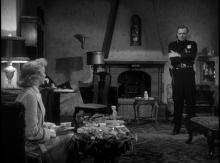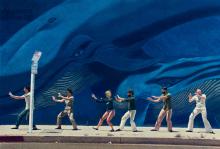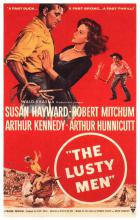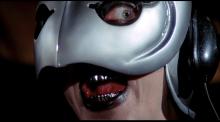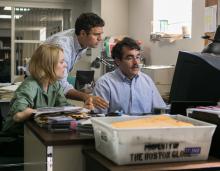This essay on Joseph Losey’s The Prowler (1951) was written by Harry Gilbert, a graduate of Williams College (B.A., History). A 35mm print of The Prowler, will screen in our Sunday Cinematheque at the Chazen "35mm Forever" series on Sunday, December 6 at 2 p.m. The 35mm restored print screens courtesy of the UCLA Film & Television Archive. Restoration funding provided by the Film Noir Foundation.
By Harry Gilbert
In a New York Times interview conducted a year before his death in 1984, Joseph Losey reflected on the ambivalent effects of the Hollywood blacklist. “Without it,” Losey mused, “I would have three Cadillacs, two swimming pools and millions of dollars, and I'd be dead. It was terrifying, it was disgusting, but you can get trapped by money and complacency. A good shaking up never did anyone any harm.” If Losey’s comments can be taken as indicators of his interests in social issues and investments in film as a mode of social critique, one could chart a trajectory that extends through the director’s oeuvre. In this respect, The Prowler (1951) is Losey par excellence.
The Prowler was produced at an historical moment in which the crime film was undergoing transformation. In the early 1940s, the plurality of crime films featured a “fugitive outsider” as the protagonist towards whom the camera structured the sympathies of the viewer. In this narrative, a working or middle class citizen, rather than the gangster or organized crime network of earlier crime films, comes into conflict with the law through false accusations or crimes of poverty, and subsequently resists social, political, and economic authority in an attempt to ascertain the true origins of the crime. Put differently, these films offered a critique of contemporary conditions that located guilt with hegemonic systems of power—the state and capitalism foremost among them—and situated the “fugitive outsider” as an ordinary person struggling to get by. This, when placed within the chiaroscuro sets of the urban environment, was film noir.
These films emerged during a period of violent and prolonged class conflict in Hollywood and the United States more broadly. Repression followed. Among other national and international factors, the House Un-American Activites Committee (HUAC) pressured unions to purify themselves of their more radical members and Hollywood studios to police—or blacklist—their more radical artists. This moment marked a shift in the dominant narratives of the crime film. By the 1950s, the police officer or detective became the protagonist, and the once sympathetic “fugitive outsider” became the criminal whose apprehension would show audiences the mechanisms of the criminal justice system and demonstrate the need to preserve order in the shadow of the Red Scare.
The Prowler, then, finds itself among a small group of films that persisted as once-effective avenues for social critique became increasingly foreclosed. Indeed, Losey goes so far as to provide a critique of the narrative shift itself. The story follows patrolman Webb Harwood (Van Heflin) to the suburban Los Angeles home of Susan Gilvray (Evelyn Keyes), who had earlier reported a late-night prowler outside of her window. Both Webb and Susan aspire to attain the American Dream. Webb is just an “ordinary guy” from a working class background who “hates being a cop” and desires to one day own a motel so that he may “make money while he sleeps.” Webb hopes to forge a path for himself that his father was too complacent to take. For Webb, the acquisition of a wife is a part of this process, and he will do whatever it takes to secure that asset. Serendipitously, Susan grew up in the same town as Webb, but lived in the other, richer community. After a few years “knocking around” Hollywood, Susan marries disc jockey John Gilvray in a “happy,” “unexciting,” and, much to Susan’s dismay, childless marriage.
The development of a physically, emotionally, and psychologically abusive relationship between Webb and Susan—despite what critics might say, the film has not persuaded me to believe that any of the interactions between the two are consensual—drives a narrative that theorizes and indicts how systems of power create the contexts in which individual decisions are made and poses questions about who is most effected and why, often with uneasy or absent answers. In a contemporary moment where the issue of race, gender, sexuality, and police oppression has re-entered mainstream (i.e., white) discourse due to the political work of people of color, these questions remain just as pressing today as they did when the film was first released.
The Prowler positions the figure of the cop outside of the law and thereby questions the role of the police, the decidedly illegal yet state-sanctioned means by which the law is enforced or skirted, and the privileges and pressures the role ordains upon a person—in this case, a man. The film thinks through the distinct ways the police as an institution exerts violence, in particular the patriarchal violence against women, and generates sympathy for itself. This critique, however, is tempered in ways that (I think) are important to consider as a viewer of the film. How does the characterization of Charles “Bud” Crocker (John Maxwell) suggest an exceptionalism to Webb that exculpates the police more generally? And how might the conclusion suggest that the police force is capable of regulating itself and thereby reinvest in the organization’s inviolability?
Susan registers the configurations of patriarchal forces in the 1950s, and her decisions enable her to survive. How might the camera-as-prowler implicate the viewer in the male gaze, one which Susan attempts to control through an internalized belief in the justice of the police and a recourse to carceral feminism? What does it mean for Susan to seek the security of marriage because of the precarity of Hollywood and capitalist labor markets for women? And how does the body of Susan become a site for masculine impotency, and how does she negotiate the repressive and creative potentials of this (im)position?
This prowler only exists outside of the frame, yet this role names the film, establishes the film, and makes possible the relationship between Webb and Susan. How do we think about the always-already racialized figure of the prowler and their visual absence from the film? Who is the “stranger” in the context of 1950s Los Angeles, with a particular history of white supremacist violence, redlining and policing neighborhoods, xenophobia, and colonialism? Bud asks us to think about how “There’s history slathered over every square foot of this country of ours.” In a film that commences with the racialized figure of the prowler, and stages the extrajudicial practices of the police and the endorsement of these measures by the state, the specter of lynching and white supremacist violence is not far. In a genre that that takes the white working class man as its subject and capitalist systems as the antagonistic object of inquiry, does The Prowler move beyond and critique this racist logic, or does it rely on them?
To pose, answer, and complicate these questions, The Prowler assembled a team of politically aligned artists who were masters of film noir. Losey himself had already directed two film noirs released in 1951 alone: a remake of Fritz Lang’s M (1931) and The Big Night. Dalton Trumbo, blacklisted in 1947 for Soviet sympathies and connections to the Communist Party, composed a screenplay credited to close friend Hugo Butler, whose name would also soon be found on the blacklist. Boris Leven, whose recent filmography included noir classics Criss Cross (1949) from Robert Siodmak and House by the River (1950) from Lang, served as art director and hired uncredited—read: blacklisted—designer John Hubley, famous for his experiments in animation, to craft the film’s sets.

